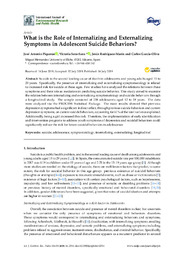Please use this identifier to cite or link to this item:
https://hdl.handle.net/11000/36028
What is the role of internalizing and externalizing symptoms in adolescent suicide behaviors?
Title:
What is the role of internalizing and externalizing symptoms in adolescent suicide behaviors? |
Authors:
Piqueras, Jose A 
Soto-Sanz, Victoria
Rodríguez-Marín, Jesús 
GARCÍA OLIVA, CARLOS  |
Editor:
MDPI |
Department:
Departamentos de la UMH::Psicología de la Salud |
Issue Date:
2019-07-14 |
URI:
https://hdl.handle.net/11000/36028 |
Abstract:
Suicide is the second leading cause of death in adolescents and young adults aged 15 to
29 years. Specifically, the presence of internalizing and externalizing symptomatology is related
to increased risk for suicide at these ages. Few studies have analyzed the relations between these
symptoms and their role as mediators in predicting suicide behavior. This study aimed to examine
the relation between internalizing and externalizing symptomatology and suicide behaviors through
a longitudinal study. The sample consisted of 238 adolescents aged 12 to 18 years. The data
were analyzed via the PROCESS Statistical Package. The main results showed that previous
depression symptoms had a significant indirect effect, through previous suicide behaviors and current
depression symptoms, on current suicide behaviors, accounting for 61% of the total variance explained.
Additionally, being a girl increased this risk. Therefore, the implementation of early identification
and intervention programs to address youth symptoms of depression and suicidal behaviors could
significantly reduce the risk for future suicidal behaviors in adolescence.
|
Keywords/Subjects:
suicide
adolescence
symptomatology
internalizing
externalizing
longitudinal |
Knowledge area:
CDU: Filosofía y psicología: Psicología |
Type of document:
info:eu-repo/semantics/article |
Access rights:
info:eu-repo/semantics/openAccess
Attribution-NonCommercial-NoDerivatives 4.0 Internacional |
DOI:
https://doi.org/10.3390/ijerph16142511 |
Published in:
International Journal of Environmental Research and Public Health 2019, 16(14), 2511 |
Appears in Collections:
Artículos- Psicología de la Salud
|
 ???jsp.display-item.text9???
???jsp.display-item.text9???

.png)
